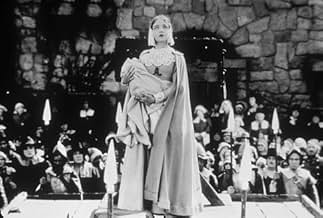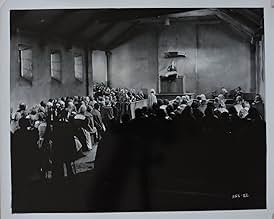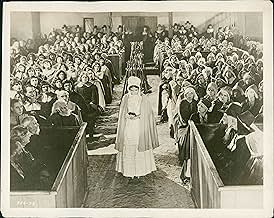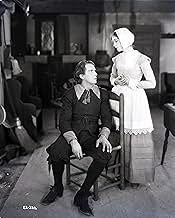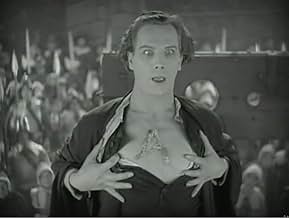IMDb-BEWERTUNG
7,6/10
2085
IHRE BEWERTUNG
Nach der Geburt eines außerehelichen Kindes wird eine junge Puritanerin unter Druck gesetzt, den Namen ihres Geliebten preiszugeben.Nach der Geburt eines außerehelichen Kindes wird eine junge Puritanerin unter Druck gesetzt, den Namen ihres Geliebten preiszugeben.Nach der Geburt eines außerehelichen Kindes wird eine junge Puritanerin unter Druck gesetzt, den Namen ihres Geliebten preiszugeben.
- Auszeichnungen
- 1 wins total
Buck Black
- Child in crowd
- (Nicht genannt)
Nora Cecil
- Townswoman
- (Nicht genannt)
Iron Eyes Cody
- Young Indian at Dunking
- (Nicht genannt)
Artye Folz
- Child
- (Nicht genannt)
Dorothy Gray
- Child
- (Nicht genannt)
Douglas Haig
- Minor Role
- (Nicht genannt)
Betsy Ann Hisle
- Child
- (Nicht genannt)
Empfohlene Bewertungen
Victor Seastrom's magnificent retelling of Hawthorne's important novel is beautifully directed with an incredible performance by Lillian Gish. It is a disgrace that this film is not available in either VHS or DVD format (and especially so since the ludicrous version with Demi Moore is).
A young mother is forced to wear THE SCARLET LETTER of adultery by her repressive society.
Nathaniel Hawthorne's classic novel is brought brilliantly to life in this excellent Silent film from MGM. Because the book was on the censored list, Lillian Gish, the era's finest actress, had to campaign vigorously with both the studio hierarchy and civic morality groups around the country to be allowed to make the film, causing her to ironically deal with the same sort of moral strictures her heroine would face in the film.
Her persistence paid off. She was able to obtain the services of director Victor Sjöström and actor Lars Hanson, both from Sweden. Sjöström instructed Miss Gish in the Scandinavian method of natural acting and he gave the film a blunt, no-nonsense look, crisp & clean, utilizing the Studio's excellent sets to the best of their advantage. Frances Marion, the most celebrated screenwriter of the day, was responsible for the literate script.
As the much harried Hester Prynne, Gish is beatific, her face radiating as if from an inner glow. She is playfully sweet as the community seamstress, wanting to cavort on the Sabbath or wear frilly clothing, only two of the actions proscribed & punishable by the Puritans' implacable rigidity. Later, with Hanson, she takes the viewer along as she delights in her new, hidden joy as he returns her love. Whether calmly standing on the scaffold to endure her shame, or fiercely protecting the unbaptized offspring of her forbidden passion, Gish never for an instant loses her grip on the pathetic character she's portraying.
Although he spoke no English, this was not a hindrance to Hanson. Playing the conflicted Rev. Arthur Dimmesdale, Boston's saintly parson, he paints the portrait of a good man literally dying of guilt, a weak man who dare not defend his wife & child. Hanson's face reflects his agony, his left hand twitching at his own breast where his secret symbol of shame is hidden. With Gish unobtainable in this world, he moves steadily towards the inevitable, and deeply poignant, conclusion.
Henry B. Walthall, Miss Lillian's costar in Griffith's THE BIRTH OF A NATION (1915), has the supporting role of a mysterious stranger whose arrival in Boston foreshadows a dire denouement for the wretched lovers.
Also in the cast are Karl Dane who acts out the viewers' dismay at the solemnity of the Puritans, most especially in the person of vindictive gossip Marcelle Corday; there is no love lost between this pair. Movie mavens will recognize diminutive Polly Moran & dour Nora Cecil as rigid Puritan matrons, both uncredited.
Nathaniel Hawthorne's classic novel is brought brilliantly to life in this excellent Silent film from MGM. Because the book was on the censored list, Lillian Gish, the era's finest actress, had to campaign vigorously with both the studio hierarchy and civic morality groups around the country to be allowed to make the film, causing her to ironically deal with the same sort of moral strictures her heroine would face in the film.
Her persistence paid off. She was able to obtain the services of director Victor Sjöström and actor Lars Hanson, both from Sweden. Sjöström instructed Miss Gish in the Scandinavian method of natural acting and he gave the film a blunt, no-nonsense look, crisp & clean, utilizing the Studio's excellent sets to the best of their advantage. Frances Marion, the most celebrated screenwriter of the day, was responsible for the literate script.
As the much harried Hester Prynne, Gish is beatific, her face radiating as if from an inner glow. She is playfully sweet as the community seamstress, wanting to cavort on the Sabbath or wear frilly clothing, only two of the actions proscribed & punishable by the Puritans' implacable rigidity. Later, with Hanson, she takes the viewer along as she delights in her new, hidden joy as he returns her love. Whether calmly standing on the scaffold to endure her shame, or fiercely protecting the unbaptized offspring of her forbidden passion, Gish never for an instant loses her grip on the pathetic character she's portraying.
Although he spoke no English, this was not a hindrance to Hanson. Playing the conflicted Rev. Arthur Dimmesdale, Boston's saintly parson, he paints the portrait of a good man literally dying of guilt, a weak man who dare not defend his wife & child. Hanson's face reflects his agony, his left hand twitching at his own breast where his secret symbol of shame is hidden. With Gish unobtainable in this world, he moves steadily towards the inevitable, and deeply poignant, conclusion.
Henry B. Walthall, Miss Lillian's costar in Griffith's THE BIRTH OF A NATION (1915), has the supporting role of a mysterious stranger whose arrival in Boston foreshadows a dire denouement for the wretched lovers.
Also in the cast are Karl Dane who acts out the viewers' dismay at the solemnity of the Puritans, most especially in the person of vindictive gossip Marcelle Corday; there is no love lost between this pair. Movie mavens will recognize diminutive Polly Moran & dour Nora Cecil as rigid Puritan matrons, both uncredited.
After years of desperately wanting to see this movie I finally got hold of a copy of it. I put the DVD in the machine and waited with baited breath, was the film going to be as wonderful as the other commenters(?)had rated it? was it going to be anywhere near as good as the other Gish/Hanson/Seastrom collaboration "The Wind"? Well, the answer was that it was everything I hoped for and more. The version I saw a recording of TCM's restoration so the quality of the print veered from superb to not quite so good, but, in all honesty that did not matter as I soon got caught up in the story of Hester Prynne and the Rev. Dimmesdale. The acting was superb by all the cast, the direction was excellent and the whole setting of the movie was outstanding. It still amazes me who there are those who will not watch a silent movie, are you crazy? This version is a million miles better than the Demi Moore/Gary Oldman version made 70 years later, the chemistry between Gish and Hanson is perfect, the child actress Joyce Coad who plays Pearl, the love child, is delightful and Henry Walthall is menacing as Roger Chillingworth, Karl Dane also deserves mentioning as Master Giles in a slightly comedic role. The only downside to the movie and it had nothing to do with the movie itself was that I bought it from a guy who contacted me via IMDb and led me to believe it was his own print, I paid $52 for a TV recording off TCM. He is contacting people concerning vintage movies so beware if someone offers to get a print of that vintage movie you want to see.
It was a novel Hollywood didn't want to touch in the mid-1920s, even though the 1850 classic was brought to the screen six times earlier. The recently-established Will Hays office had its censorship fangs out. A story about a married woman who gets pregnant by a lover was cause for alarm for most movie studios.
Lilian Gish, one of silent film's major star, had long wanted to bring Nathaniel Hawthorne's 'The Scarlet Letter' in an updated version to the screen. Contracted to MGM in a three-picture deal, she convinced the studio's head of production, Irving Thalberg, she could deliver a tasteful version of Hawthorne's book without moralistic tongue-waggers complaining. With a script by Frances Marion, which follows the novel closely, MGM's August 1926's "The Scarlet Letter" has been praised as the best version of the book in a long-line of past and future movie adaptations.
Its success can be attributed to Gish herself, who portrays Hester Prynne. She hasn't heard from her husband who traveled overseas for several years from their Puritan Boston, Massachusetts, home in the mid-1600s. She becomes pregnant from a man whom she doesn't disclose the name. The Gish version departs from Hawthorne in a couple of major ways: the film begins a year earlier than the author's, showing her condemned to a stockade for leaping and dancing after her song bird escapes its cage. It's there where she meets the Reverend Arthur Dimmesdale (Lars Hanson). Also, the films unveils the love relationship between the minister and Hester, not keeping secret of who's the father of the baby.
Another reason for the movie's overall financial popularity is Swedish director Victor Sjostrom's unique directing. He allowed Gish the freedom to display her attractiveness by literally letting her hair down in a clandestine meeting with Dimmesdale in the woods, reflecting Hester's modernistic independence. Gish had the choice in selecting the director, and she picked Sjostrom because she "felt the Swedes were closer to the feelings of New England Puritans than modern Americans." She also favored Hanson as Dimmesdale from his 1924 performance in "The Saga of Gosta Berling." Hanson, who knew very little English, elected to speak his lines (it was a silent movie after all) in Swedish while Gish spoke English in scenes where they're together. Homesick actress Greta Garbo, recently arriving in America from Sweden after signing a contract with MGM, was a near daily presence on the set since she was comfortable speaking her native language with Hanson.
With two weeks of filming to go, Lillian found out her mother suffered a stroke in London and reportedly dying. Dorothy, her sister, urged her to catch the first boat to England to attend to her. In a near impossible request, Lillian asked Sjostrom she needed to leave in three days to travel by train to New York City, then on to a liner to London. The director didn't flitch. He designed an almost around-the-clock schedule to film all of Gish's parts-as long as the crew agreed to the grueling sleepless itinerary. The workers heartedly agreed.
"The Scarlet Letter" is still admired for Sjostrom's creation of an environmental rise en scene that underscored the film's characters' emotion and psychology by its pastoral recreation of a 17th century village. Even though the residents of Salem, MA, where the story takes place, were insulted by their forefathers' portrayal in the film, the American Film Institute nominated it as one of the most passionate motion pictures ever made as well as nominated Hester Prynne as one of movie's most admired heroes.
Lilian Gish, one of silent film's major star, had long wanted to bring Nathaniel Hawthorne's 'The Scarlet Letter' in an updated version to the screen. Contracted to MGM in a three-picture deal, she convinced the studio's head of production, Irving Thalberg, she could deliver a tasteful version of Hawthorne's book without moralistic tongue-waggers complaining. With a script by Frances Marion, which follows the novel closely, MGM's August 1926's "The Scarlet Letter" has been praised as the best version of the book in a long-line of past and future movie adaptations.
Its success can be attributed to Gish herself, who portrays Hester Prynne. She hasn't heard from her husband who traveled overseas for several years from their Puritan Boston, Massachusetts, home in the mid-1600s. She becomes pregnant from a man whom she doesn't disclose the name. The Gish version departs from Hawthorne in a couple of major ways: the film begins a year earlier than the author's, showing her condemned to a stockade for leaping and dancing after her song bird escapes its cage. It's there where she meets the Reverend Arthur Dimmesdale (Lars Hanson). Also, the films unveils the love relationship between the minister and Hester, not keeping secret of who's the father of the baby.
Another reason for the movie's overall financial popularity is Swedish director Victor Sjostrom's unique directing. He allowed Gish the freedom to display her attractiveness by literally letting her hair down in a clandestine meeting with Dimmesdale in the woods, reflecting Hester's modernistic independence. Gish had the choice in selecting the director, and she picked Sjostrom because she "felt the Swedes were closer to the feelings of New England Puritans than modern Americans." She also favored Hanson as Dimmesdale from his 1924 performance in "The Saga of Gosta Berling." Hanson, who knew very little English, elected to speak his lines (it was a silent movie after all) in Swedish while Gish spoke English in scenes where they're together. Homesick actress Greta Garbo, recently arriving in America from Sweden after signing a contract with MGM, was a near daily presence on the set since she was comfortable speaking her native language with Hanson.
With two weeks of filming to go, Lillian found out her mother suffered a stroke in London and reportedly dying. Dorothy, her sister, urged her to catch the first boat to England to attend to her. In a near impossible request, Lillian asked Sjostrom she needed to leave in three days to travel by train to New York City, then on to a liner to London. The director didn't flitch. He designed an almost around-the-clock schedule to film all of Gish's parts-as long as the crew agreed to the grueling sleepless itinerary. The workers heartedly agreed.
"The Scarlet Letter" is still admired for Sjostrom's creation of an environmental rise en scene that underscored the film's characters' emotion and psychology by its pastoral recreation of a 17th century village. Even though the residents of Salem, MA, where the story takes place, were insulted by their forefathers' portrayal in the film, the American Film Institute nominated it as one of the most passionate motion pictures ever made as well as nominated Hester Prynne as one of movie's most admired heroes.
There just aren't enough words to describe the beautiful performances in this film....not that words are needed, then or now. Victor Seastrom's lovingly crafted scenes provide perfect visual frames for the transcendent performances of Lillian Gish and Lars Hanson. An artistic triumph for everyone concerned, and a bittersweet reminder of what was lost with the death of the art of the silent film. (The Turner restoration is alas, also bittersweet, as prints of wildly differing quality had to be "married" in order to create a substantially complete copy of the subject. Thus, viewers move from scenes that shimmer with pristine beauty to muddy, contrasty dupes. It's a tribute to the art of all concerned however, that this is not the distracting issue it might be with a lesser film. Like any work of art, you won't notice the cracks and flaws after a while if you're paying attention as you should. It's just a shame that the entire film isn't as mint-fresh as some of its scenes.)
Wusstest du schon
- WissenswertesLillian Gish learned that her mother had had a stroke in London and her sister, Dorothy Gish, urged her to get there on the first available boat. When Lillian informed director Victor Sjöström of the need to finish the film quickly, he created a shooting schedule that crammed two weeks worth of shooting into three days of non-stop work. The crew worked without complaint so that she could finish the film early and catch the earliest possible train to New York.
- Zitate
Mistress Hibbins: I am wrongly accused! Never hath my tongue been given to gossip!
The Governor: Falsehood! Her tongue hath wagged like the tail of a dog! Duck her again!
- Alternative VersionenIn 2000, Turner Entertainment Co. copyrighted a restored version with a musical score written by Lisa Catarineau and Mark Northam and a running time of 98 minutes. Its previous version ran 79 minutes.
- VerbindungenFeatured in Oscar '71 (1971)
Top-Auswahl
Melde dich zum Bewerten an und greife auf die Watchlist für personalisierte Empfehlungen zu.
- How long is The Scarlet Letter?Powered by Alexa
Details
- Erscheinungsdatum
- Herkunftsland
- Offizieller Standort
- Sprache
- Auch bekannt als
- Nathaniel Hawthorne's the Scarlet Letter
- Drehorte
- Produktionsfirma
- Weitere beteiligte Unternehmen bei IMDbPro anzeigen
Box Office
- Budget
- 430.290 $ (geschätzt)
- Laufzeit1 Stunde 55 Minuten
- Sound-Mix
- Seitenverhältnis
- 1.33 : 1
Zu dieser Seite beitragen
Bearbeitung vorschlagen oder fehlenden Inhalt hinzufügen

Oberste Lücke
By what name was The Scarlet Letter (1926) officially released in India in English?
Antwort
